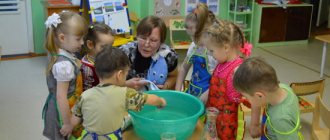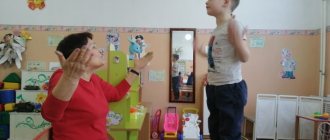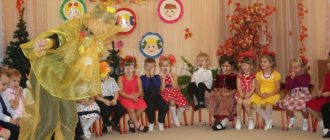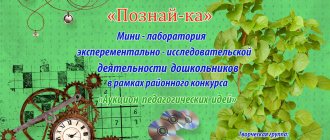Card file of observations for walks in the preparatory group. Spring
The preparatory group is attended by children of senior preschool age - 6-7 years old. For a child, this period is considered responsible. It is designed to prepare children for school. The teacher’s task is to create conditions for learning and conduct classes that will prepare the child intellectually, morally and physically for school. And also quickly adapt and socialize in first grade.
Children on a walk
The teacher of the preparatory group selects materials and prepares notes for intellectual and entertaining classes in accordance with the Federal State Educational Standard. Children learn better and remember new material faster if it is presented in an interesting and playful way.
When teaching children to observe the surrounding nature, the cognitive process should be gradual. Children should see how nature changes month by month and analyze each change together with the teacher.
This complex process involves the child's cognitive functions, such as:
- speech;
- thinking;
- attention;
- auditory, visual and tactile perception.
By the end of the preparatory group, the children receive basic knowledge about living and inanimate nature and understand the role of humans in it.
Observation of living and inanimate nature
Purpose: to give an idea of spring and the change of year.
Studying icicles up close
Observation March preparatory group: Go out with the children for a walk, preferably on a sunny day. Tell that March is the first month of spring. The sun gets warmer and the snow begins to melt. It gradually turns into water, which is absorbed into the soil. The plants drink it and their growth begins. The first grass appears, and leaves grow on the trees and buds swell.
Tell a rhyme:
Spring has arrived. In the spring, the buds swelled and the leaves hatched. Look at the maple branches - How many green noses there are! Author: T. Dmitriev
Additional Information. Show the children icicles and explain how they appear. Offer to place a bucket under the dripping icicles. Let the children observe how much water collects. Then, water the plants with this water.
Watch the snow melt. Let the guys take shovels and clear the paths. The snow will be placed in the sun and in the shade. They will observe where it melts faster. The teacher must explain why this happens.
Read S. Marshak’s poem “March”: The loose snow darkens in March, the ice on the window melts.
Observe the operation of a snowblower. Explain that she takes the snow to the fields where it melts. Tell why they do this. Invite the children to play: whoever removes the snow faster will jump further up from their spot.
Talk about animals. In spring, migratory birds arrive and wild animals, such as bears, emerge from hibernation. Later, when it gets warm, the birds will begin to build nests and have chicks. The animals will have offspring. In the group, show pictures of who has which animals.
Observations in March in the preparatory group are of an introductory nature.
Bird watching in spring
Purpose: to show the life and behavior of birds in spring.
Building a bird feeder in early spring
Observations:
- In the yard the children can see sparrows, tits, pigeons and rooks. The teacher says that birds select a mate, build nests and lay eggs. One bird hatches them, and the other carries the worms for food, because the eggs cannot be left behind. Explain why.
- Children listen to birdsong. Together with the teacher, they hang up the feeder and put food in it. Explain what birds eat.
- Explain what hatched chicks eat and how they learn to fly. Until November, migratory birds fly to warm countries for the winter.
- The teacher asks questions about the material covered.
- Invite the children to clean up the area. Divide them into groups and monitor their joint work.
- Play: let the children be birds and run away from the teacher. Take the ball and ask them to hit the target, so the guys will develop their eye and strength.
Cognitive abilities of preschoolers
Weather observation
Goal: develop observation skills.
Observations:
- Children notice changes in the environment every day: the snow around is melting, the sun is getting warmer every day, the sky is clearing. The clouds become lighter and blue skies are visible more often. Explain how clouds form. In May the sky turns bluish.
- In early spring there is frequent rain and hail. Tell where they come from and why. There is a temperature difference - the higher, the colder. There, the steam that rises from the water on the ground turns into ice. Rain often comes with hail.
Ask a riddle:
Fluffy cotton wool: Floating somewhere. The lower the cotton wool, the closer the rain. (Cloud)
Additional Information! Invite children to sprinkle sand on the paths. Remove trimmed branches from trees and bushes.
Watching the sun
Goal: Find out how the sun affects plants, animals and humans.
Observations:
- Tell that with each spring day the sun gets higher and the days get longer. It rises from the east and sets in the west. Show cardinal directions. The sun's rays hit the plants and because of this, their growth occurs. For good health and well-being, you need to be in the sun as often as possible.
- Invite the children to touch the stones. Those on which the sun's rays fall become warm because they heat up. And the stones in the shade remain cold.
- Explain that planets revolve around the sun.
- Play: the teacher is the sun, and the children are the planet. They walk around and then run away. The teacher catches them.
Additional Information! Bring sunglasses with dark lenses. Tell them that they protect the eyes from bright rays.
Birch tree observation
Goal: to develop knowledge about birch.
Birch tree observation
Observations:
- Show tree. Let the children remember what it looks like.
- Tell that the birch tree has roots. They are strong and go deep into the ground. Roots are needed for the tree to stand strong in the wind. Birch, with the help of its roots, consumes moisture and nutrition from the ground. In the roots they turn into juice, which rises first up the trunk, then into branches and leaves. If you make a hole, it will flow and you can drink it. In April, birds make nests on birch trees, insects land and caterpillars crawl, which then turn into butterflies. In winter, in February, hares eat the bark because there is little food for them at this time. Tell that in autumn the leaves on the tree turn yellow and fly off.
- Offer children a game where they will list all the trees they know.
- Let the children collect fallen branches from the area.
- They will learn to walk in formation.
Soil monitoring
Goal: find out information about the land.
Observations:
- Let the guys observe in which place the earth dries out faster. Explain why this depends on sandy soil more quickly than on clayey soil. Sandy soil is looser, it absorbs water faster and lets it pass through it deeper. Clay is more dense, so the process of moisture absorption occurs more slowly and in early spring this takes about a week. Let the children note that plants grow better and faster in sandy soil.
- Invite the children to dig up different soils and compare them themselves. See that there are small roots, sticks and leaves in the ground. Let them take a watering can and water the soil one by one, and see which one dries out faster.
- Give the children the task of bringing fresh soil under some tree roots.
- Play jump rope, exercises with which strengthen muscles and develop coordination of movements.
A child at 5 years old - what children should know and be able to do by the age of five
“What do we know about the snowball?” IOD in the middle group
Author - compiler:
Krylova Natalya Mikhailovna,
teacher
MADOU d/s No. 162 of the city of Tyumen
Summary of cognitive and research activities in the middle group
“What do we know about the snowball?”
as part of the project “Miracles for the New Year”
Goal: To stimulate children's curiosity, the desire to study natural phenomena (snow and its properties), to support children's interest in experimentation and research.
Program content:
- To form basic ideas about snow and its properties (snow melts in warmth, snow is not transparent, snow is white, snow has no smell).
- Teach children to draw conclusions through experimentation.
- Activate children's speech. Improve children’s ability to answer questions posed based on the content of the conversation.
- To develop thinking, interest in winter natural phenomena, the desire to actively learn and act.
Preliminary work
- Looking at paintings on a winter theme.
- Reading poems about winter and snowflakes.
- Observing falling snow, snowflakes, playing with snow on walks. 4. Drawing snowflakes.
Materials and equipment:
Demonstration - two containers for water, cold and warm water, toys Fixiki Nolik and Simka, TSO (laptop, TV, stereo system, flash drive with the musical game “Raking Snow with Your Hands...”, with the cartoon “What dangers can lurk in winter”, snowflake, cards depicting the main properties of snow.
Distribution - disposable plates for snow (for each child a deep and flat plate), snow, half a cut apple on two plates, a disposable spoon, plastic figures of a hedgehog and a fox, individual napkins.
GCD move
Educator: Guys, we have a lot of guests today, let’s say hello to them (the children say hello).
(The laptop is standing on the window, suddenly the sound “Oh-oh-oh” is heard from it (these are the screams of Nolik from the cartoon about Fixies))
Educator: Oh, what is that noise? Where is he from? (children with a teacher approach the laptop).
Children: These are probably Fixies.
Educator: Such miracles for the New Year!
Educator: Where are they, where did they hide?
(Children look for Fixies in the group room, go to the bedroom, see Fixies Nolik and Simka on the bed).
Educator: Who’s that under the blanket here? (It’s Fixies)
Educator: What are they doing? (They're warming up)
Educator: I understand. All night the laptop stood by the open window, and snow fell on the Fixies. So they froze and ran into the bedroom to warm themselves.
Educator: Guys, the Fixies told me that they came to visit us in order to find out what we know about snow. Shall we tell them? (we'll tell you).
Educator: Well, then come in and sit on the carpet. And you, Fixies, make yourself comfortable and listen to us carefully. Together we will find out what kind of snow it is and what its properties are.
Educator: Guys, I brought snow to the group in the morning, but what happened to the snow now? (he melted)
Educator: Let's take and carefully examine the melted snow (places a container with melted snow in the middle).
Educator: What do you see? (we see water. The water has become dirty).
Educator: Guys, why is the water dirty? (There is a lot of dirt on the street, smoke from cars has settled on the snow. The snow is gray and dirty).
Educator: Guys, I saw that some children eat snow. Are they doing the right thing? (no, not correct)
Educator: Why can’t you eat snow? (snow is cold and dirty).
Educator: So, the snow melts, water is formed. To help us remember this, I will draw a picture of a drop of water on a card.
(a snowflake with the image of the first property is attached to the board: snow melts in warmth).
Educator: Oh, all the snow has melted, but how will we study it further? Where can we get it? (let's ask the junior teacher to bring us snow from the street)
Educator: Guys, come to the large common table, we will find out other properties of snow.
(The container with snow is placed in the middle of the table)
Educator: Let's touch the snow, what does it feel like? (cold).
Educator: Let's conduct an experiment. You have figures on your plates, name them (hedgehogs and chanterelles). What color are they? (gray, orange)
Educator: Put the fox in a flat plate, put a snowball on top, and put the hedgehog in a deep plate (the teacher pours water into a deep plate).
Educator: Which animal figurine is visible and which is not? (a hedgehog is visible, but a fox is not visible)
Educator: Why? (snow is not transparent, you can’t see anything through it, but the water is transparent)
Educator: So, the snow is not transparent. To help us remember this, I will draw and attach this card to the snowflake.
Educator: Guys, look at the plates and tell me what color is the water? (colorless) What about snow? (snow is white)
Educator: What else is white? (cotton wool, clouds in the sky, drawing paper...)
Educator: So, the snow is white. To help us remember this, I will draw cotton wool on a card and attach it to a snowflake.
Educator: Guys, how do you know if snow smells? (you have to smell it).
Educator: Smell the snow, and now smell the apple. Does it smell like snow? (snow has no smell)
Educator: So, snow doesn’t smell. To help us remember this, I will draw a nose on the card and cross it out.
Educator: Fixies, do you know that we have an interesting game that we love to play with the guys, and we want to teach you how to play it.
Musical game “ Raking snow with your hands...”
(children perform movements to the music in accordance with the words together with the teacher)
Educator : Well done! We have conducted so many experiments together, and now I want to show you another experience.
Educator : (at the demonstration table) Look: I have two jars. We pour cold water into one (the child is invited to check
water temperature - touches), (cold). In the second, pour warm water (touch the container and make sure it’s warm). I drop snow into these jars at the same time (drops snow in two spoons).
Educator : Where did the snow melt faster and where slower? (it melted faster in a jar of warm water).
Educator : That's right, the warmer the water, the faster the snow melts, the speed of snow melting depends on the temperature of the water.
Educator: Guys, let's tell the Fixies about snow (children use reference drawings to talk about the properties of snow).
Educator: And now the Fixies invite you to watch a small cartoon in which they will introduce us all to the dangers that await us in winter.
List of used literature
1. Solomennikova O.A. Classes on the formation of elementary ecological concepts in the middle group of kindergarten. Lesson notes. – M.: Mosaic - Synthesis, 2007.- 48 p.
2. Novikovskaya O.A. Notes of complex classes with children 4-5 years old. Zip format file. ... Publisher: Parity ISBN 978-5-93437-248-5; 2008 208 pp.
3. Dybina O.V. Classes on familiarization with the outside world in the middle group of kindergarten. Lesson notes. – M.: MOSAIC – SYNTHESIS, 2010. – 80 p.
4. Reader for 4-5 years. V. Gerbova, N. Ilchuk and others - published by M. AST, 1997.
5. Nikolaeva S.N. Young ecologist. System of work in the middle group of kindergarten. For classes with children 4-5 years old. – M.: MOSAIC – SYNTHESIS, 2010. – 144 pp.: color. on
6.https://ru123.iplayer.info/song/109922136/Fizminutka_-My_igraem_v_snezhki./
“Certificate of publication in the media” Series A No. 0004913
We invite teachers of preschool education in the Tyumen region, Yamal-Nenets Autonomous Okrug and Khanty-Mansi Autonomous Okrug-Yugra to publish their teaching materials: - Pedagogical experience, original programs, teaching aids, presentations for classes, electronic games; — Personally developed notes and scenarios of educational activities, projects, master classes (including videos), forms of work with families and teachers.
Why is it profitable to publish with us?
1. “Kindergartens of the Tyumen Region” is an officially registered specialized media outlet at the federal level. 2. The activities of the editorial office are supported by the Department of Education and Science of the Tyumen Region 3. We issue a “Certificate of Publication” in the media. 4. The document has a unique number, is entered in the register, has the original seal of the editorial office of the online publication and signature. 5. “Certificate of publication” in the media is sent to the author in both paper and electronic versions.
Details >>>
Sample “Certificate of publication of author’s methodological material in the media.”pdf
Share
Organization of surveillance
To organize observation, you need to properly prepare the process:
- Choose a plant or animal that looks healthy.
- The place must be clean and consistent with natural conditions.
- The chosen place should be well lit, it is better if the light falls slightly from the side.
- Children need to be positioned so that none of them interfere with each other or block the view.
- If possible, each child should touch a plant or pet an animal.
Convenient placement of children around the object being studied
Approximate plan for a walk-observation
The process of reviewing and discussing an object should comply with the following recommendations:
- Children need about 2 minutes to make their first impression. During this time, the children will have time to examine the object and satisfy their curiosity.
- The teacher should talk about the object in 1 minute.
- Next, children’s thoughts need to be directed in the right direction. If necessary, read a poem or ask a riddle. This is how the children form an emotional attitude towards the object. The time should not exceed 7 minutes.
- Afterwards, the object is examined in detail. The teacher asks leading questions and helps with answers. Provides missing information. This will take no more than 10 minutes.
- At the end, a summary is summed up and all the knowledge gained is connected with each other. This process takes about 5 minutes.
Additional Information! The teacher can start a colorful observation diary together with the children.
Children's research activities during a spring walk
Research activity involves the child’s independent search for information.
Organization
You can organize the process in the following ways:
- Children, while answering questions about the object in question, try to correctly express their own thoughts.
- When observing an object for a long time, the guys notice all the changes and, if necessary, record them.
- When observing living or inanimate nature, additional items are used: dark glasses, gardening tools.
- During an excursion, when they go to the city, to a library, a food factory, or when observing construction work, production technology or the process of organizing services is studied.
- After visiting the museum, a more detailed study occurs by looking at the encyclopedia or other materials.
You can also organize experiments under the close supervision of a teacher.





